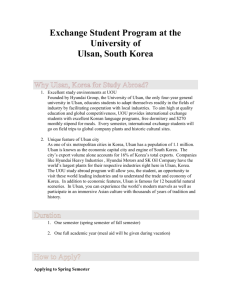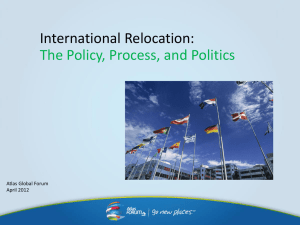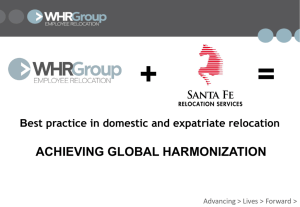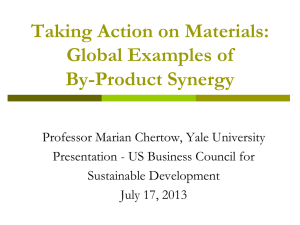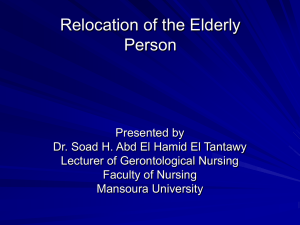466KB - Kitakyushu Initiative for a Clean Environment
advertisement
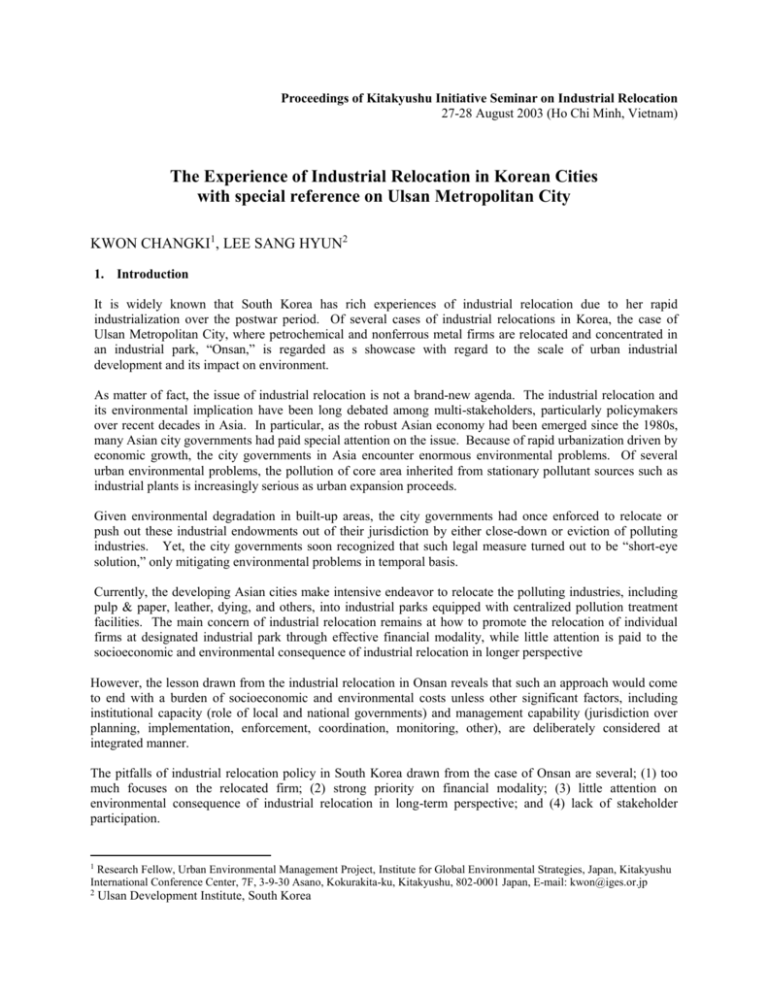
Proceedings of Kitakyushu Initiative Seminar on Industrial Relocation 27-28 August 2003 (Ho Chi Minh, Vietnam) The Experience of Industrial Relocation in Korean Cities with special reference on Ulsan Metropolitan City KWON CHANGKI1, LEE SANG HYUN2 1. Introduction It is widely known that South Korea has rich experiences of industrial relocation due to her rapid industrialization over the postwar period. Of several cases of industrial relocations in Korea, the case of Ulsan Metropolitan City, where petrochemical and nonferrous metal firms are relocated and concentrated in an industrial park, “Onsan,” is regarded as s showcase with regard to the scale of urban industrial development and its impact on environment. As matter of fact, the issue of industrial relocation is not a brand-new agenda. The industrial relocation and its environmental implication have been long debated among multi-stakeholders, particularly policymakers over recent decades in Asia. In particular, as the robust Asian economy had been emerged since the 1980s, many Asian city governments had paid special attention on the issue. Because of rapid urbanization driven by economic growth, the city governments in Asia encounter enormous environmental problems. Of several urban environmental problems, the pollution of core area inherited from stationary pollutant sources such as industrial plants is increasingly serious as urban expansion proceeds. Given environmental degradation in built-up areas, the city governments had once enforced to relocate or push out these industrial endowments out of their jurisdiction by either close-down or eviction of polluting industries. Yet, the city governments soon recognized that such legal measure turned out to be “short-eye solution,” only mitigating environmental problems in temporal basis. Currently, the developing Asian cities make intensive endeavor to relocate the polluting industries, including pulp & paper, leather, dying, and others, into industrial parks equipped with centralized pollution treatment facilities. The main concern of industrial relocation remains at how to promote the relocation of individual firms at designated industrial park through effective financial modality, while little attention is paid to the socioeconomic and environmental consequence of industrial relocation in longer perspective However, the lesson drawn from the industrial relocation in Onsan reveals that such an approach would come to end with a burden of socioeconomic and environmental costs unless other significant factors, including institutional capacity (role of local and national governments) and management capability (jurisdiction over planning, implementation, enforcement, coordination, monitoring, other), are deliberately considered at integrated manner. The pitfalls of industrial relocation policy in South Korea drawn from the case of Onsan are several; (1) too much focuses on the relocated firm; (2) strong priority on financial modality; (3) little attention on environmental consequence of industrial relocation in long-term perspective; and (4) lack of stakeholder participation. 1 Research Fellow, Urban Environmental Management Project, Institute for Global Environmental Strategies, Japan, Kitakyushu International Conference Center, 7F, 3-9-30 Asano, Kokurakita-ku, Kitakyushu, 802-0001 Japan, E-mail: kwon@iges.or.jp 2 Ulsan Development Institute, South Korea For example, the development process of Onsan industrial park, in which central and local governments allowed target industries to negotiate land acquisition with landlords in order to facilitate the swift completion of industrial relocation, caused reckless industrial estate development. As a result, the governments at both central and local level have been asked to pay unintended costs such as the relocation of residents along with financial compensation due to environment-related diseases. This paper aims to examine what kinds of policy components related to industrial relocation should be considered through reviewing the Korean case of industrial relocation as well as to offer more innovative policy options toward sustainable urban environmental management in Asia. Following brief introduction of urban development in Ulsan, this paper reviews the steps to carry out relocation program and incentives or supporting policies with special focus on the details of development process. This paper is expected to provide relevant policy recommendations for Ho Chi Minh City in the progress of their pilot project on industrial relocation and to disseminate the experience of industrial relocation in Korean to other Asian cities in Asia-Pacific region as further reference. 2. Background information of Ulsan Metropolitan City The City of Ulsan, a port city and industrial hub, is located at the southeastern end of the Korean Peninsula. (see Fig. 1). This industrial city is one of the seven largest cities in Korea which has about one million inhabitants with one thousand and fifty-five square kilometers of total area. The fertile land is created by the Taehwa River. Onsan and Bang-eo-jin ports, which are connected to Ulsan Bay. The land of 63 million square meters along with the seashore provides the foundation for the development of Ulsan as an industrial city. In addition, the downtown area of Ulsan is divided into a new and old section, and the periphery of the city, consisting of agricultural lands and green belt. Seoul Ulsan Pusan Figure 1. The Map of South Korea Ulsan has the largest land resources of Korea’s seven major cities, enabling it to both expand urban areas and to develop factory sites. 115 km2 out of a total land area of 1,056 km2 are designated for built-up area for urban activity, and the rest is designated for forestry and agriculture. 67 km2, accounting for 7% of the total nonurban areas are available for immediate development. ONSAN Figure 2. The Map of Ulsan Metropolitan City Being located adjacent to Pusan, which is the second largest city in South Korea and plays as one of the major marine transportation hubs in Northeast Asia, Ulsan is an ideal logistics and trading post for the robust Korean economy. Currently, Ulsan is becoming a main gateway to marine cargo transportation; 11 weekly trips on 14 sea routes to Japan; 10 weekly trips on 11 routes to Southeast Asia; 4 weekly trips on 4 routes to China. At present, Ulsan Port has a 90 berth capacity and handles about 135 million tons of ocean cargo. This accounts for 19.3% of the nation’s total cargo handling. It handles 53% of the nation’s entire petroleum imports and 45.7% of the nation’s total auto exports. By 2011, when a new port is completed with capacity of 29 berths, the annual cargo handling capacity of Ulsan Port will reach to 30 million tons. Since then Ulsan district was raised to the status of Ulsan eup (a town) on April 1st, 1931, and raised to that of Ulsan City on June 1st, 1962 as well as designated as a special industrial zone. The now merged urban and rural Ulsan was inaugurated on Jan. 1st, 1995, and Ulsan was raised to the status of Ulsan Metropolitan City which comprises of four districts and one county on July 15, 1997 The road ratio (road/land ratio) of municipal area is 25.5%, highly above the average of Korea’s seven major cities. The city has convenient one or two-hour-connections with the major metropolitan areas of Pusan and Daegu via the Seoul-Pusan Expressway and 5 national road routes. As a result, any locality in the country can be reached within one day. There is a rail system with links to ports and national industrial complexes. The comprehensive transportation links to ports, railroad and highway create an ideal logistics base. There is a domestic airport with regular flights to Seoul and Jeju Island. Gimhae International Airport is within one-hour driving. Given the location and other socioeconomic advantages, Ulsan, becomes the industrial capital of the robust South Korean economy. 3. Ulsan: Korea’s Industrial Capital Ulsan is the biggest industrial city in South Korea, consisting of a number of industrial parks at both national and local level (see Table 1). As of 2002, this industrial city has 6 national and regional industrial parks and three local industrial parks are expected to be open by 2011. Two national industrial parks are established by central government, while the rest of industrial parks are operated by either local government or quasi-public sector. With regard to municipal structure concerned with industrial relocation, there is division of works among several departments of the city government in Ulsan. Two development-related departments (Economic & Trade Bureau, Construction & Transportation Bureau, Urban Affairs Bureau) are mainly charged for the related issues of industrial relocation (planning, implementation, enforcement, coordination, monitoring, and others), while Environment Bureau is responsible for environment protection. Table 1. Industrial Parks in Ulsan Metropolitan City Classification Complex name Land area Key industry (1,000 ㎡) National industrial complex Ulsan-Mipo 46,135 Automobile, petrochemicals Onsan 17,071 Nonferrous petrochemicals metal, 212 companies moved-in Dalcheon 264 Assembly electric and electronic metal, 83 companies moved-in Sangbuk 139 Transportation 1st metal equipment, 9 companies moved-in Duseo 123 Transportation assembly metal equipment, 16 companies moved-in Dudong 70 Transportation equipment Maegok 556 Auto parts, equipment Samgdong 236 New materials, optical equipment Rural industrial parks Regional industrial complex New industrial 2,525 complex IT, new materials Remarks shipbuilding, 558 companies moved-in 4 companies moved-in machinery, To be by 2003 created precision, To be by 2004 created To be by 2011 created Source: www. metroulsan.go.kr (1) Financial structure As of 2001, total budget of the city is 975,100 million Korean won (Self-Sufficiency Rate of Fiscal Resource: 66.2%) and substantial share of the annual budget channels into municipality-affiliated public enterprises responsible for the provision of urban services, including water supply, drainage, and other public services. As in other aspects of industrial relocation, the financial role of city government is quite limited due to poor financial capacity. In addition, the share of financial contribution is differentiated by the level of government with regard to public expenditures in industrial relocation. Table 2. The Details of Municipal Budget in Ulsan Metropolitan City (hundred million won)3 General account 6,789 (69.6%) Special accounts 2,962 (30.4%) Public Enterprise Others Subtotal Water Supply 2,295 (23.5%) Drainage 631 (6.5%) Public Development 188 (1.9%) Local Development Fund 540 (5.5%) Subtotal 667 (6.9%) Railway Removal 53 (0.5%) Housing Industry 152 (1.6%) Traffic Industry 164 (1.7%) Other Industries 298 (3.1%) 936 (9.6%) Source: www. metroulsan.go.kr (2) Environmental Portfolio Ulsan, an industrial hub of the postwar growth in Korea, demonstrates another example of urban environmental management associated with industrial pollution. In particular, the case of Ulsan illustrates the time-lag between cause and pressure in urban environment. Prior to the 1970s, the city suffered less environmental problems, despite heavy-polluting industries were located in most industrial complexes. Yet, as the HCI (Heavy and Chemical Industrialization) of the Korean economy was driven by the central government and Ulsan accounted for the predominant share in terms of industrial production, the city has unveiled a variety of industry-related environmental problems since the late 1970s. Up to the date, the agglomeration of heavy industry and the population growth in Ulsan are still the major factors to compound environmental problems. Facing these environmental challenges, the government enacted a wide range of user-charge measures, focusing on the reduction of emission and waste since the late 1980s. The major environmental charging systems include Emission Charge System in 1983, Deposit refund for waste disposal in 1992; waste treatment charge system in 1993, Environmental improvement charge system, volume-based collection fee for domestic waste in 1995. These measures contribute to some extent to secure financial resources for environmental management as well as to reduce the discharge of pollutant. Due to such intensive efforts made by city government, several environmental indices show that Ulsan had achieved substantial improvement of environmental quality since the mid-1990s (see Table 3 & 4). Table 3. Air Pollution of Ulsan Metropolitan City, 1997 - 2001 unit standard Sulfurous Oxide (SO₂ ) PPM/year 0.020 0.018 0.014 0.014 0.012 0.013 Carbon nitrogen (NO₂ ) PPM/year 0.050 0.023 0.019 0.019 0.020 0.023 Carbon monoxide (CO) PPM/8hours 9.0 0.9 Ozone (O₃ ) PPM/8hours 0.060 0.016 0.017 0.019 0.020 0.022 Minute dust (PM10) ㎍/㎥-year 70 75 Source: www. metroulsan.go.kr 3 pollution item 1 US $ is equivalent to 1,170 Korean Won (As of August, 2003). '97 '98 0.7 65 '99 0.7 65 2000 0.7 40 2001 0.9 - Table 4. Water Pollution of Ulsan Metropolitan City, 1997 - 2001 (unit:㎎/ℓ) Classification Water Degree Item Standard Pollution '97 '98 '99 2000 2001 upper stream mg BOD below1 1.3 1.8 1.5 1.8 2.1 lower stream mg BOD below3 10.0 7.8 3.9 4.9 6.9 Hoeyagang mg BOD below3 3.9 2.1 2.4 3.8 3.6 Dongcheon mg BOD below1 20.8 3.3 2.7 5.1 5.4 Ulsanman mg COD below2 2.1 1.6 1.7 2.4 1.3 Onsanman mg COD below2 2.3 1.9 1.4 2.3 1.9 Taehwa river Coast Source: www. metroulsan.go.kr 4. Industrial Relocation: The Case of Onsan Industrial Park As in other Asian cities, Ulsan has rich history of industrial development since the 1970s, when HCI (Heavy and Chemical Industrialization) was driven by central government. Prior to the 1970s, most polluting industries were widely scattered across major metropolitan areas, including Seoul, Pusan, and Taegu. On one hand, the majority of Small and Medium–sized Enterprises (SMEs), producing consumer goods, is located at either city center or the fringe due to easy access to market and labor. On the other hand, heavy and chemical industries prefer largely to be located in costal region equipped with port infrastructure due to access to resource and production requirements (utilities, water supply, and transport infrastructure, etc.). The underlying rationale of spatial agglomeration of HCI made significant influence on industrial location policy in South Korea, in which central government tried to maximize economic benefits through scale economy of industry and agglomeration. Given such different endowment of industries in terms of location, Onsan industrial park was established in 1974 and 212 relocated firms produced petrochemical, nonferrous metal, and timber companies by 2002 (see Figure 5). As mentioned earlier, while little attention has been paid to environment consequence of industrial concentration during the development of this industrial park, the “Outbreak of Pollution-related Disease” (ONSAN Disease) had drawn great attention on adverse environmental externalities since the mid-1970s. Figure 5. Onsan Industrial Park In 1986, the Korean government decided to finalize “The Plan for Relocation of Resident in Onsan Industrial Park,” under strong pressure from the public and environmental NGOs. In fact, the environmental costs of industrial relocation in Onsan’s case, there are three major environmental problems; air pollution (SO2), marine contamination (BOD & COD); and soil contamination (metal). For example, the soil concentration of hazardous metals in Onsan is far beyond government-set limits as well as national average; Cu (1,1176%) and Cd (325%) (see Table 5). As a result, the Korean government was forced not only to pay enormous socioeconomic cost due to environmental degradation, but also to implement several policy measures. The major steps taken by the Korean government include “Emission Charge System” in 1983, “Deposit Refund for Waste Disposal” in 1992; “Waste Treatment Charge System” in 1993, “Environmental Improvement Charge System” in 1995. In addition, the government enforced the relocated firms in Onsan industrial park to install advanced pollution treatment facility as well as to employ cleaner production technology to production process. In fact, the environmental condition of Onsan industrial park is gradually improved over last decade due to intensive efforts of environmental protection. For example, the water quality of Onsan Bay, which is next to industrial park and blamed for marine contamination during the 1970s – 80s, has been improved since the early 1990s (see Figure 6) . Although such PPP (Polluter-Pay-Principle) and cost-recovery contributed to mitigate environmental problems, these measures are not enough to prevent further environmental degradation both the inside of industrial park and the surrounding areas. Table 5. Soil Contamination in Onsan Industrial Park in 1999 (unit: ㎎/㎏) Nation Average Limit Onsan PH 6.28 Cd 0.158 1.500 4.880 6.80 Cu 4.36 50.00 588.40 As 0.38 6.00 1.30 Pb 6.32 100.00 69.95 Source: White Paper of Environment in Ulsan, 2000 Water quality of Onsan, 1991 - 2001 60.0 50.0 Temp.(°C) 40.0 PH 30.0 BOD (mg/l) 20.0 COD (mg/l) 10.0 0.0 1 2 3 4 5 6 7 8 9 10 11 Year Figure 6. Water Quality of Onsan, 1991 - 2001 So far, it is believed that two pitfalls is blamed for the environmental disaster of Onsan industrial park; policy failure in terms of development process and land use planning. As shown in Table 6, Onsan industrial park was planned exclusively for industrial use, although the share of greenery (32.3%) and residential area (11.7%) is substantial, respectively. On the development stage, government had negotiated with only the relocated firms, not with landlords and residents in the area. By the way, the relocated firms were only concerned with the purchase of cheaper lots without any consideration on overall land use planning scheme. As a consequence, the location of firms was scattered across the entire area of industrial park and a number of polluting plants are located just next to residential area. Table 6. Land Use of Onsan Industrial Park Industrial Residential Commercial Greenery & Others Total Size (Pyung in thousand) 5,150 1,082 34 2,990 9, 256 Percentage (%) 55.6 11.7 0.4 32.3 100.0 Source: KAIST, 1982 4. Concluding Remarks Regardless of the divergent socioeconomic development, the majority Asian cities are mostly encountering serious environmental challenges due to rapid urbanization and industrialization. Although the rapid urban growth of these cities has been considered unavoidable, but it induced unintended spill-over of environmental degradations in Asian cities. Although the experience of industrial relocation is different from city to city due to divergent socioeconomic conditions, the lessons drawn from the development of Onsan industrial park suggest that the following prerequisites should be reflected in the entire development process of industrial relocation. Building Institutional Capacity Enhancing Management Capability o Planning in integrated manner o Implementation in coherent manner o Enforcement & monitoring in consistent manner o Coordination in harmonic manner In addition, the case of Onsan industrial park confirms that the environmental concern of industrial relocation should be fully integrated into development process at both national and local level. Otherwise, other Asian cities, where the relocation of polluting industries is seriously considered, would repeat Onsan’s failure sooner or later.
